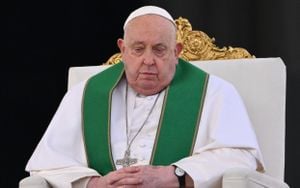Russia is showing signs of willingness to agree to the use of approximately $300 billion of its frozen assets for the restoration of Ukraine, but only on terms favorable to Moscow. This potential agreement is part of preliminary discussions reportedly held with U.S. representatives, according to multiple unnamed sources cited by Reuters.
Since the onset of the war and following sanctions imposed by the United States and its allies, Russia has seen its sovereign assets frozen. These include government bonds primarily held across European, American, and British depositaries. The funds, totaling between $300 billion and $350 billion, have become a focal point for potential negotiations aimed at resolving the conflict.
While exact details remain sparse and the negotiations are described as being in very early stages, Russian officials have outlined conditions for the use of these assets. Reports suggest they would like to see part of the funds allocated for the reconstruction of Ukrainian territories currently under Russian control. Specifically, one source indicated discussions are centering around the use of two-thirds of the frozen assets for Ukraine's restoration, contingent on strict reporting guarantees. The remaining third would be aimed at restoring areas under Russian control.
This reflects Russia's broader strategy as it navigates the geopolitical fallout of the war. The idea of utilizing frozen funds for Ukraine restoration has not been publicly explored by Moscow before, marking it as potentially the first indication of compromise offered by Russia to end hostilities.
Notably, previous Russian reactions to the U.S. and EU proposals to redirect these frozen assets for Ukraine support have been dismissive, labeling such actions as theft. Sputnik previously reported Russian officials as expressing vehement opposition to efforts aimed at repurposing frozen funds without consent.
Meanwhile, Ukrainian President Volodymyr Zelensky has expressed readiness to revive peace talks, but insists on involving European countries as key stakeholders. Following conversations with UK Prime Minister Keir Starmer, Zelensky made it clear through social media platforms, stating, "Europe must sit at the negotiating table to end the military conflict and provide reliable security guarantees." His approach emphasizes the interconnectedness of Ukraine's security with the broader European security architecture.
Zelensky's insistence on Europe's involvement stems from his acknowledgment of the political climate and the necessity for comprehensive security guarantees, which he deems non-negotiable for any resolution to the conflict. He has also noted the active military and political cooperation between Ukraine and the UK as pivotal to forming solid strategies for upcoming diplomatic engagements.
During the Munich Security Conference on February 14, Zelensky told attendees he would only engage with President Vladimir Putin after consulting with U.S. allies. He remains firm on not accepting any decisions made without Kyiv's consent, underscoring his administration's proactive stance on foreign engagement and military strategy.
The situational dynamics surrounding the discussions on frozen assets and their potential use for Ukraine's recovery present both challenges and opportunities for conflict resolution. With significant funds locked away since the onset of the war, the possibility of partial release, coupled with structured repayment models, could serve dual purposes: assisting with urgent humanitarian needs and fostering dialogue.
U.S. officials, following their own protocols, have previously begun utilizing profits from these frozen assets to support Ukraine. For example, last December, the U.S. Treasury Department announced a $20 billion credit for Ukraine as part of the G7 initiative, specifying income from frozen Russian assets would be responsible for servicing this credit. This creative use of assets has set precedents for how countries may navigate the complex financial web stemming from sanctions.
This broader narrative of financial strategy interwoven with diplomatic dialogues creates layers of complexity. Should Russia's conditions be duly considered, there might be avenues for bridging gaps with Ukraine and its allies. These developments warrant close observation, as they are likely to dictate future diplomatic channels and peace frameworks.
Given the layers of negotiation on both sides, the path to peace remains fraught with obstacles, yet the prospect of involving Europe's perspective might lend urgency and traction to talks. The interplay of economic aid through frozen assets may lay groundwork for renewed cooperation, underscoring the need for shared dialogues as the region navigates uncertain futures amid the continuing conflict.



